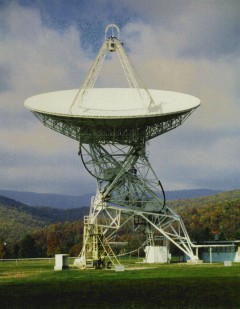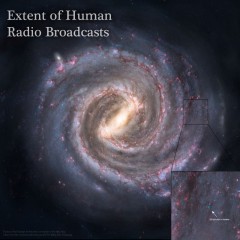
“Life, even cellular life, may exist out yonder in the dark. But high or low in nature, it will not wear the shape of man.”
— Loren Eiseley
Interactions between humans and other intelligent species in the Universe has been one of the most favorite subjects of science fiction stories in literature, cinema, and television alike, often depicted with a varying degree of realism, ranging from the scientifically plausible to the outright absurd. The real-life search for extraterrestrial intelligence, or SETI, which has been ongoing for more than half a century, has shifted the subject from a mere philosophical speculation to that of real scientific inquiry, while carrying the potential to successfully discover signs of other intelligent civilisations in the galaxy, at any given time. The first part of this article examined the limits of our human perceptions in our ability to acknowledge such a discovery. This article examines some of our basic preconceptions regarding the nature of extraterrestrial intelligence.
Since the first radio search for other intelligent civilisations was conducted in 1960 by American astronomer Frank Drake, SETI scientists have pondered the possible consequences of their search on the rest of society. With time, more and more experts from a wide variety of scientific fields, including psychology, anthropology, and the social sciences, began to study the emotional, intellectual, and cultural implications of a possible successful SETI outcome. To aid their efforts in the absence of a confirmed discovery, researchers have often used analogies drawn from various instances in the history of our own civilisation when two very different cultures with entirely different levels of technological sophistication came into contact for the first time. In addition, a vast number of surveys and polls conducted through the years regarding the public’s beliefs on the existence of extraterrestrial intelligence have allowed researchers to make some educated guesses about the public’s reactions on a hypothetical contact event. The examination of our beliefs regarding the possible nature of extraterrestrial intelligence is as interesting and illuminating as the study of the possible outcomes from contacting it.
Angels and Demons
Even though a plethora of possible contact scenarios have been discussed in the scientific literature, two major themes have dominated the general public’s and the scientific community’s perception through the years regarding the nature of extraterrestrial intelligence, often derived from the way the latter has been portrayed in various science fiction stories on cinema and television: either as a benevolent agent of a higher knowledge, seeking to enlighten and educate humanity, or as malevolent imperialistic force of conquer, oppression, and destruction.

The notion of an advanced and benevolent extraterrestrial intelligence envisions a civilisation that has managed to transition from the stage of the so-called “technological adolescence” stage in its development toward maturity, successfully overcoming the threat of self-annihilation coming through the use of weapons of mass destruction, or as a result of overpopulation, environmental pollution, and other self-inflicted catastrophes. According to this theme, any such civilisation would have much to teach humanity in its own struggle through this critical evolutionary process. The late American astronomer Carl Sagan often speculated on the possibilities of such a contact, often viewing it as the key to humanity’s future: “A single message from space will show that it is possible to live through technological adolescence … It is possible that the future of human civilization depends on the receipt of interstellar messages” [1]. Yet, for many, this vision of a wise, utopian society descending to help and guide humanity through the perilous times of its infancy and teach it how to grow and live in perfect harmony with its environment is more based on traditional religious beliefs of divine intervention and spiritual ascendance through the help of an all-powerful Being than on scientific arguments. “In the threatening situation of the world today, when people are beginning to see that everything is at stake, the projection-creating fantasy soars beyond the realm of Earthly organizations and powers into the heavens, into interstellar space, where the rulers of human fate, the gods, once had their abode in the planets,” argued renowned psychiatrist Carl Jung in his essay regarding the UFO phenomenon [2]. Yet, despite its similarity to religious or spiritual beliefs, the notion of a morally and technologically superior extraterrestrial civilisation makes sense from an evolutionary point of view. “Over the centuries terrestrial societies have become more inclusive, more democratic, more peaceful and altruistic. Societies following these trends endure while autocratic, egotistic and controlling societies given to the use of bluff and force, succumb to internal dissention and external threat,” writes Albert Harrison, Professor Emeritus at the University of California’s Department of Psychology [3]. “Of course, unjustified optimism could have disastrous consequences. This was true when a crusade was sent forth to join the powerful (but non-existent) army of a glorious and perfectly parallel (but also non-existent) Christian empire led by Prester John, and later on when Montezuma mistook the explorer Hernando Cortez for the lost god Quetzalcoatl and delivered his civilization to the Spanish conquistadors.”
Drawing from these dark chapters of human history, the second theme envisions that if contact were to be made with any highly advanced extraterrestrial civilisations, then the latter would be ruthless invaders, hell-bent on conquering and enslaving humanity in order to acquire its resources, or destroying it completely in order to safeguard their own survival against the threat that our civilisation would pose to them. One of the more outspoken proponents of this view in recent years is world-famous British theoretical physicist Stephen Hawking, who argues that SETI should not attempt to contact any intelligent civilisations it may find. “We only have to look at ourselves to see how intelligent life might develop into something we wouldn’t want to meet,” he cautioned in his Discovery Channel documentary Into the Universe with Stephen Hawking. “I imagine they might exist in massive ships, having used up all the resources from their home planet. Such advanced aliens would perhaps become nomads, looking to conquer and colonise whatever planets they can reach…If aliens ever visit us, I think the outcome would be much as when Christopher Columbus first landed in America, which didn’t turn out very well for the Native Americans.”
Although based on the history of our own civilisation this seems like a reasonable scenario, it nevertheless fails to explain exactly how a sufficiently advanced civilisation with the capability to cross vast interstellar distances, being able to alter the properties of space and time and colonise the entire galaxy, would find the Earth’s resources of any particular value, let alone perceive human existence as particularly threatening. “Based on the infeasibility of sustained exponential expansion through space, it seems less likely that other extraterrestrial intelligence will destroy us because of their lack of resources,” according to Bauman et al, in their own analysis of various possible SETI contact scenarios [4]. “Nevertheless, it could still decide to harm us intentionally because of their own ethical considerations, or they may cause us unintentional harm through invasive species or cultural collapse.” For astronomers Martin Dominik and John Zarnecki, the whole argument in favor of a contact scenario with a hostile alien species seems moot. “If data are absent or ambiguous, we tend to argue by retreating to analogies or theories about universalities [5]. “Historical examples, however, need to be well understood before these can serve as a guide, which is demonstrated by the fact that history is full of misinterpretations and misconceptions of itself. Rather than aliens invading Earth, most likely detection scenarios will involve microbial organisms and/or extra-terrestrial life at a safe distance that prevents physical contact.”

There is, however, a more basic point to this issue. The development of radio communication and radio transmission technology during the late 19th and early 20th centuries has over the years given our Home Planet a very distinguishable and powerful “radio signature,” detectable across vast astronomical distances; most of our radio and television signals have been “leaking” into space continuously for the past 80 years. The latest episodes of the The Ed Wynn Show, I Love Lucy. and The Three Stooges have now reached hundreds of Sun-like stars within a radius of 100 light-years from Earth. Even though the strength of these transmissions constantly decays the further they move away from our Home Planet, these signals will nevertheless be powerful enough to be intercepted by any potentially hostile intelligent species living on any of the exoplanets that could possibly circle those stars. Our own unintentional radio transmissions into space have guaranteed that we have long made our presence known to anyone who might be listening. Even if we decided today to remain “radio silent” as a civilisation, we would have to shut down every cell phone, radio, and television signal transmitter on the planet, and discontinue the use of every military, astronomy, and air-traffic control radar—an obviously impractical proposition.
As evidenced by the many different cultures of our contemporary civilisation which display a huge diversification among the different nations, the portrayal of extraterrestrial intelligence as entirely benevolent or malevolent seems more like an oversimplification than an understanding of cultural dynamics. “Indeed, much of the literature on contact with extraterrestrial intelligence tacitly assumes that an alien civilization will be culturally unified, unlike our own world,” comments John W. Traphagan, a professor of Religious Studies and a faculty affiliate of the Population Research Center at the University of Texas, Austin [6]. “In essence, this is a very anthropocentric approach that assumes an underlying similarity in all intelligent beings, in the ways in which ‘culture’ is expressed, and in how culture shapes civilizations … The odds are that, without an understanding of an extraterrestrial culture—one derived from hard data rigorously analyzed—we will interpret what we find in terms of values, structures, and patterns of behavior associated with our own culture (itself a problematic idea since there is no single human culture on Earth) … However, given the differences that exist among human cultures in terms of how we perceive, interpret, and categorize our surroundings, it is reasonable to think that a truly alien society would consist of beings who do these things in ways unlike those of humans.”
For many researchers, the realities of interstellar communications may render our preconceived notions of extraterrestrial intelligence obsolete. “In all likelihood, should we have an encounter with an alien intelligence, that experience will be neither physical nor continuous,” argues Douglas Raybeck, Professor Emeritus in the Department of Anthropology at Hamilton College in New York [6]. “Rather we are most apt to find either a message or a remote probe. In either event, acknowledging the current strictures of space-time and of Relativity Theory, there will be a significant lag between exchanges of information. Given the improbability of physical contact with aliens, there would seem to be little chance for hostile confrontations, even if intelligent extraterrestrials had untoward motives, as is quite possible.”
Ultimately, the portrayal of other intelligent life in the Cosmos as either a divine force of good or a malevolent force of destruction seems to be more indicative of our own hopes and fears, projected on the infinite depths of interstellar space. Seen in this light, the Cosmos functions more like a vast canvas upon which humanity’s collective unconscious projects its inner angels and demons, as archetypes of the way we view ourselves, rather than the manner in which any possible extraterrestrial intelligence might eventually treat us.
http://www.youtube.com/watch?v=tykCWO-abUUVideo Credit: Richard Dawkins Foundation for Reason and Science/Sh3llShock87
References:
1. ‘The Quest for Extraterrestrial Intelligence’, Cosmic Search Vol. 1 No. 2, Big Ear Radio Observatory.
2. ‘Flying Saucers: A Modern Myth of Things Seen in the Sky’, Princeton University Press.
3. ‘Fear, pandemonium, equanimity and delight: human responses to extra-terrestrial life’, Philosophical Transactions A of the Royal Society, 2011 369.
4. ‘Would Contact with Extraterrestrials Benefit or Harm Humanity? A Scenario Analysis’, Acta Astronautica, 2011, 68(11-12): 2114-2129.
5. ‘The detection of extra-terrestrial life and the consequences for science and society’, Philosophical Transactions A of the Royal Society, (2011) 369, 499–507.
6. ‘Archaeology, Anthropology, and Interstellar Communication’, NASA e-Books series.
Want to keep up-to-date with all things space? Be sure to “Like” AmericaSpace on Facebook and follow us on Twitter: @AmericaSpace



